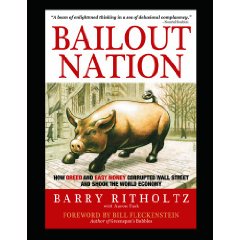 A quick Bailout Nation excerpt:
A quick Bailout Nation excerpt:
The decision to allow Lehman Brothers to go belly up has been roundly criticized by many people as a mistake that cost AIG dearly. That turns out to be an incorrect conclusion, a classic causation versus correlation error. It is much more accurate to observe that the same factors that drove Lehman into bankruptcy also drove AIG to the brink.
It began with rates so low that everyone in the nation decided they wanted a house (and the bigger, the better). This included many people who could not afford one. So these folk applied for mortgages from a new kind of lender, one that operated with little regulation and even less supervision. These lenders were able to give loans to these people – bad credit risks, too little income, no equity – due to their unique business model. They could ignore traditional lending standards because they did not plan on holding these mortgages very long; They could specialize in higher commission sub-prime loans because they were “lend–to-securitize” originators. They made higher risk loans, then flipped them to Wall Street firms, who repackaged them into complex mortgage backed securities. These same investment banks had too little capital and used too much leverage, but that didn’t stop them from buying too much of this paper from each other. It didn’t matter much anyway, since it was rated triple AAA rated by S&P and Moody’s, so there wasn’t anything to worry about. Underlying all of these transactions was the assumption that home prices in the USA never went down. Oh, and, this entire series of events took place at a time when the dominant political philosophy was that it was impossible for this to go wrong . . . the self-regulating markets, you understand, would see to that.
What bad could possibly come of that?
Indeed . . .


What's been said:
Discussions found on the web: